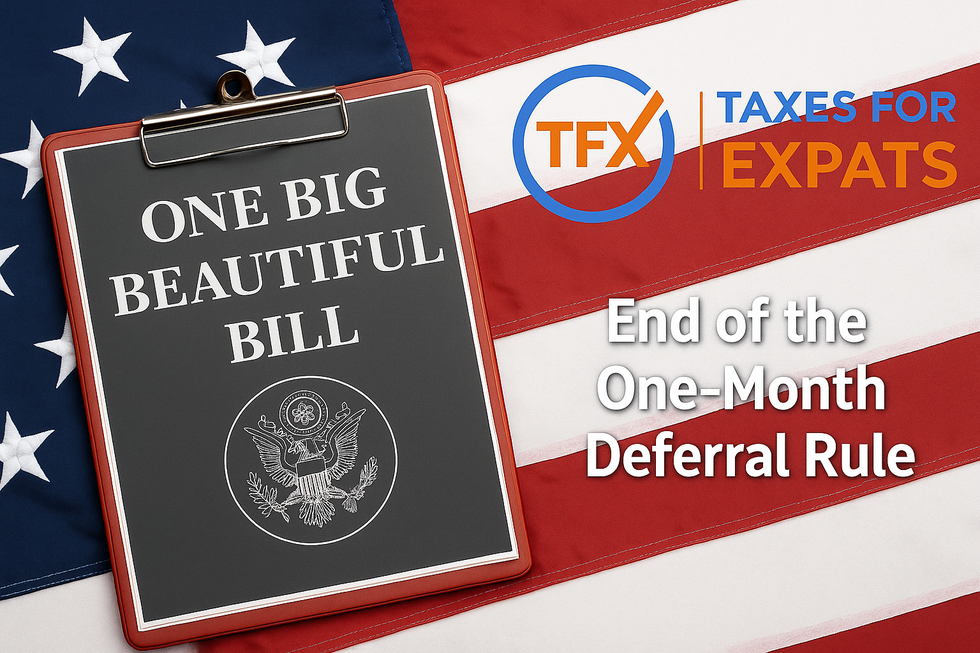IRS Notice 2025-72: What the end of the one-month deferral rule means for foreign companies

If your group has been using a one-month deferral for foreign subsidiaries, the clock just ran out.
On November 25, 2025, the IRS released Notice 2025-72. It announces forthcoming proposed regulations and describes rules taxpayers can rely on now for allocating foreign income taxes after the repeal of the one-month deferral election under section 898(c)(2) and for modifying section 987 transition rules in short taxable years.
This is a niche, technical change. It targets specified foreign corporations and their US shareholders – typically US individuals or groups that own controlled foreign corporations (CFCs) and already deal with Form 5471, GILTI, Subpart F, and foreign tax credits.
For that audience, the notice matters in very practical ways. It affects when foreign taxes are treated as paid, how much GILTI or Subpart F income flows into US taxable income in a transition year, and how pre-transition §987 foreign currency gains and losses are spread where a short taxable year is involved.
In this update by Taxes for Expats, we break down Notice 2025-72 in plain English, explain who is actually affected, and outline the key decisions international businesses and US owners should be considering before their first post-OBBBA year-ends.
Quick background: What changed under OBBBA
The One, Big, Beautiful Bill Act (OBBBA) repealed the one-month deferral election under section 898(c)(2). This election allowed many specified foreign corporations to use a non-calendar year that ended one month earlier than the year of their majority US shareholder (for example, November 30 vs. December 31).
After the repeal:
- Foreign corporations that used the one-month deferral must now conform to the majority of US shareholders’ year-end.
- Most affected companies will experience a one-month “first required year” during the transition.
- Without new guidance, this short year would cause major distortions in foreign tax credit timing, GILTI calculations, and Subpart F inclusions.
Notice 2025-72 is the IRS’s solution to that problem.
What Notice 2025-72 says about allocating foreign taxes
The core of Notice 2025-72 is a set of rules explaining how foreign income taxes must be split between the short transition year and the following taxable year once the one-month deferral is repealed. Without these rules, many foreign subsidiaries would have all of their foreign taxes artificially pushed into the short year – distorting GILTI, Subpart F, and foreign tax credit calculations.
The IRS created a structured allocation system so taxpayers don’t face timing distortions simply because their foreign corporation was forced into a one-month year-end change. The mechanics are technical, but the intent is straightforward: align foreign tax timing with economic activity, not with an accidental short year.

Below is a high-level breakdown of how the allocation framework works and who it applies to.
Who counts as an affected corporation
Two definitions matter:
- Specified Foreign Corporation (SFC) – basically a foreign company that counts as a CFC because US owners control more than 50% of it. That’s the group this IRS notice applies to.
- Affected Corporation – is a CFC that (1) used the one-month deferral, (2) uses the accrual method for foreign taxes, and (3) is required by the new law to change its year-end after November 30, 2025.
NOTE! This does not apply to every company with a different year-end – only those that had the one-month deferral election.
The short-year problem
Suppose your CFC closes its books on November 30. Under the repeal, it must adopt a December 31 year-end.
This creates:
- A one-month “first required year” (December 1–31, 2025), followed by
- A full 12-month calendar year for 2026 and onward.
Under local law, your foreign tax authority may still treat December 1, 2024, to November 30, 2025, as a full taxable year – meaning 12 months of foreign tax could fall into a one-month US year.
Without relief, that mismatch could:
- Push too much foreign tax into the short year,
- Create “losses” in certain income groups under US rules, and
- Block deemed-paid foreign tax credits under §960.
Notice 2025-72 prevents those distortions.
How the new allocation rule works
The notice introduces a structured method to split foreign taxes across the short year and the following year.
At a high level:
- Identify “specified foreign income taxes” (SFITs): These are the foreign income taxes that the affected CFC itself owes for the transition year. This does not include partnership-level taxes or withholding taxes – only the taxes the CFC is directly responsible for.
- Assign those taxes to US income groups: (Using §1.861-20 principles at a very high level – no need to burden the reader with technical rules.)
- Calculate the allocation percentage: The IRS formula compares the portion of foreign-law taxable income attributable to the short US year, divided by the total foreign-law taxable income for the relevant foreign taxable year.
- Split each foreign income tax using that percentage: Part is treated as accruing in the short year, and the rest accrues in the succeeding year.
These allocations feed into:
- Subpart F,
- GILTI,
- High-tax exception/exclusion, and
- §960 deemed-paid foreign tax credits.
This ensures the transition year doesn’t cause artificial tax results.
What does not get special treatment
Some categories remain on their normal timetable, including:
- Certain partnership-level foreign taxes,
- Some withholding taxes, and
- Foreign taxes that truly belong to the succeeding taxable year.
Section 987 changes: What expats should know
Imagine you own a foreign company that suddenly shifts into a one-month short taxable year because the one-month deferral has been repealed. That short year doesn’t just affect foreign income taxes – it can also shift how your foreign currency gains and losses are recognized under section 987, which is why the IRS issued transition timing rules alongside the allocation guidelines.
For owners of foreign companies, section 987 can move real tax numbers when a foreign branch or QBU keeps its books in a non-USD currency. Notice 2025-72 updates how old (“pre-transition”) section 987 currency gains or losses are spread out over time. Instead of a 10-year schedule, the IRS is moving to a 120-month schedule.
This matters most for expats running multicurrency operations, where even small timing shifts can influence US taxable income. It also matters when distributions or restructuring events fall near the transition date, because those actions interact directly with §987 timing. In simple terms: if you have a foreign business with currency exposure, these rules stabilize the transition and prevent unnecessary volatility in your US return.
Who needs to act immediately
US expats who own foreign companies should take a few quick steps to confirm whether the transition rules apply to them. These checks ensure you understand how the year-end change and foreign tax allocation rules may affect your US reporting.
US expats who own foreign companies should
- Confirm your ownership status – determine whether you are a majority US shareholder in any foreign corporation.
- Check your company’s year-end – identify whether the entity used the one-month deferral and whether a short transition year will occur.
- Review tax impacts – understand how the new rules may influence: GILTI, Subpart F, and Foreign tax credit timing.
- Reach out to TFX early – we can review your structure, model the transition, and apply the allocation and §987 timing rules directly in your return.
Taxes for Expats supports US expats, international taxpayers, and foreign business owners with the complex calculations behind Notice 2025-72. We handle the transition mechanics for you – from foreign tax allocation to GILTI/Subpart F timing – and ensure your US return reflects the new rules correctly.




